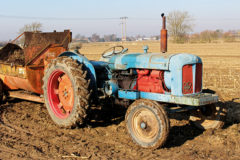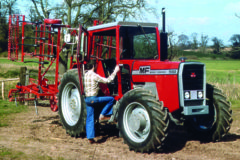1977 Ford D-Series tipper
Posted by Chris Graham on 5th August 2021
David Reed tells the story of Johnny Murphy’s newly-completed and sympathetically-restored, 1977 Ford D-Series tipper.
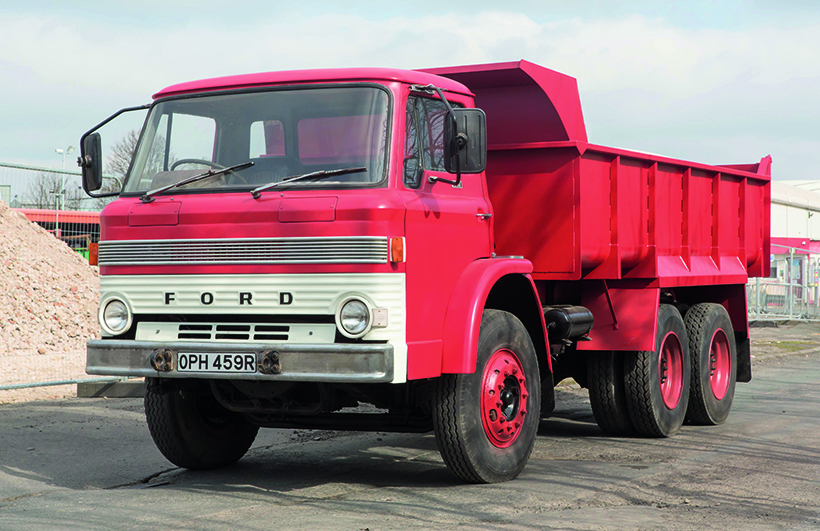
Johnny Murphy’s sympathetically-restored, 1977 Ford D-Series tipper.
Like the Albion featured recently in Classic & Vintage Commercials magazine, OPH 459R was new to RMC as a cement mixer. It was then bought by Wallman Haulage and used in ‘Pertwee’ contract livery for lime-spreading duties. After that it was advertised for sale, still in Geoff Wallman’s ownership. “I went down to Ipswich to have a look at it,” Johnny said, “but the cab was pretty shot, so I turned it down.”
But another reason for Johnny’s reluctance to buy the D Series was the fact that he’d just bought STK 473L, a 1972 D2014 dropside. “It had an excellent cab and was powered by a Ford 360 turbo engine,” he explained. “So, I wasn’t keen to buy another, similar, lorry that needed a fair amount of work doing to it.”

It wasn’t long before OPH 459R found a new home, though. “It was sold to Ben Few, a local man who ran a fleet of tippers. He bought it as a donor vehicle for a 6×4 D Series MkII that he was restoring for his father.” By that stage, Johnny had seen Paul Bibby’s newly-restored D Series. “It sparked my interest no end. It looked fantastic and I realised that I wanted a tipper just like that.” Johnny duly got in touch with Paul. “I told him that if he ever wanted to sell it, he should get in touch.”
A year or so later, however, Johnny had another opportunity to buy OPH 459R, thanks to a tip-off from Paul Bibby. “I heard through a friend that a man was wanting to buy STK 473L. As good as it was, I decided to let it go.” The timing couldn’t have been better. “Paul told me that OPH 459R could be bought,” Johnny continued. “It was a non-runner by then, many parts were missing and it had been left in a field.” Johnny soon got in touch with Ben Few and travelled down to see the D Series again.
Unfortunately, with so many parts having been removed, the condition of the D Series left something to be desired. “I didn’t talk to Ben for a while after my visit, but I still wanted to buy the D Series, so Ben kindly offered to put as many salvageable parts back on it as he could, and sell it to me as a runner, which really helped,” Johnny said. It took a few months for the D Series to be repaired by Ben and his father who, apparently, really enjoyed working on the vehicle.
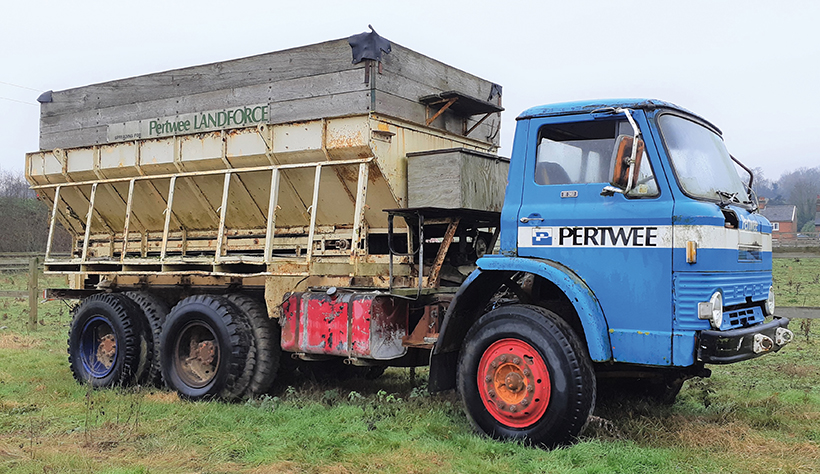
The Ford D Series as found by Johnny Murphy, still carrying its lime-spreading body and in Pertwee colours.
With the deal completed, OPH was transported to Huddersfield. “After having so many Ford D Series in the past, at last I had a 6×4 with a Perkins engine which was exactly what I wanted,” Johnny admitted.
It was obvious that OPH needed a new cab but, just before the 6×4’s arrival in Huddersfield, a small Ford D Series eight-tonner came up for sale on eBay at a ‘buy it now’ price. “It looked to have a good cab so I travelled down to Essex to see it,” Johnny explained. He wasn’t wrong. “I could see that some repairs had been made to the cab in the past, but it was the best that I could find for the money, so I clicked ‘Buy it now’ as soon as I got home.

A complete, eight-tonne D Series was bought as a cab donor vehicle.
John had some help from Paddy John Reynolds with transporting the small D Series to Paul Parker’s yard in Manchester. “I’ve known Paul for many years. He kindly removed the cab and then bought the rest of the vehicle from me; there was nothing else compatible with or useful for my heavier 6×4.” The cab was then transported to Huddersfield, and stripped down ready to be fitted to OPH.
When the 6×4 D Series finally arrived, the first job was to remove the rusted hopper, which had originally been fitted to an Atkinson gritter, and scrap it. Then, a few months later, the original rusted cab was swapped and scrapped too. This was completed with the help Johnny’s youngest son, Luke, and Chris Wise, who had previously done cab lifts for Johnny.
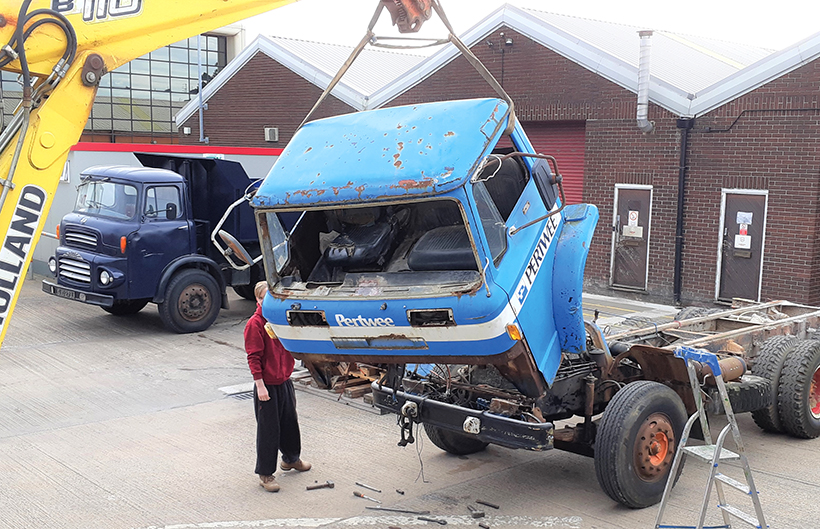
The rusty old cab being removed from OPH 459R at Huddersfield, ready for the better replacement to be fitted.
The old cab did provide some useful components, though. “The wiring loom was only 12 Volts and not suitable for the 6×4, so I transferred the one from the old cab to the new one.” Then, with the steering column being refitted, the chassis was driven into the shed for the work to continue. “Paul Bibby was a big help, and kindly provided some bits and pieces to help me out with the restoration,” Johnny acknowledged.
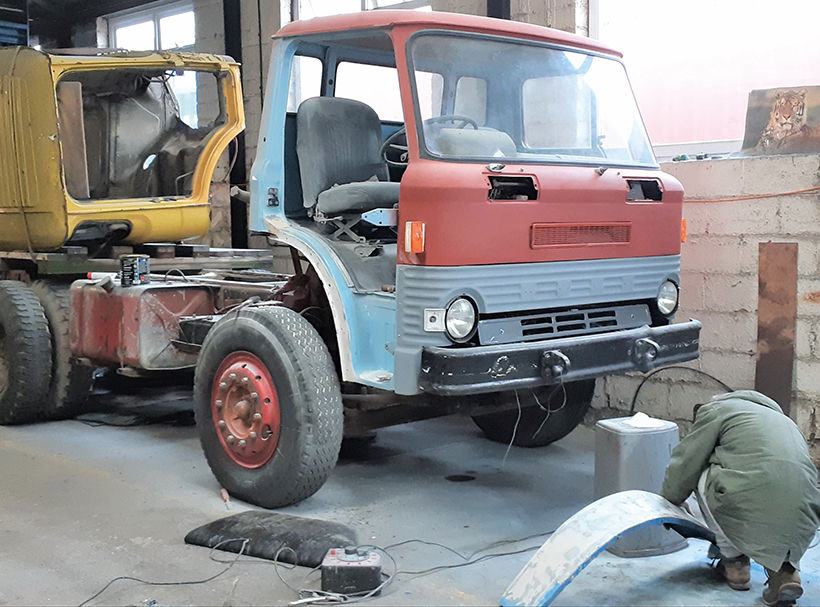
The replacement cab – from the eight-tonne donor – being fitted to OPH 459R.
Although the ‘new’ cab was in reasonably good condition, there were still some jobs to do to it, which turned out to be quite tricky. “We had to change the narrow wings to the wider type that were used on the heavier Fords, due to the wider front axle,” Johnny continued. “Seamus Clarke, from Ireland, gave me a brand-new wing. While Paul Bibby provided a secondhand one that my son, Luke, knocked back into shape.” There were still difficulties to overcome, though. “The old wings were joined to the cab with fibreglass, and had to be ground off,” Johnny said. “It was a bit of a mess afterwards with, some rot still needing attention.”
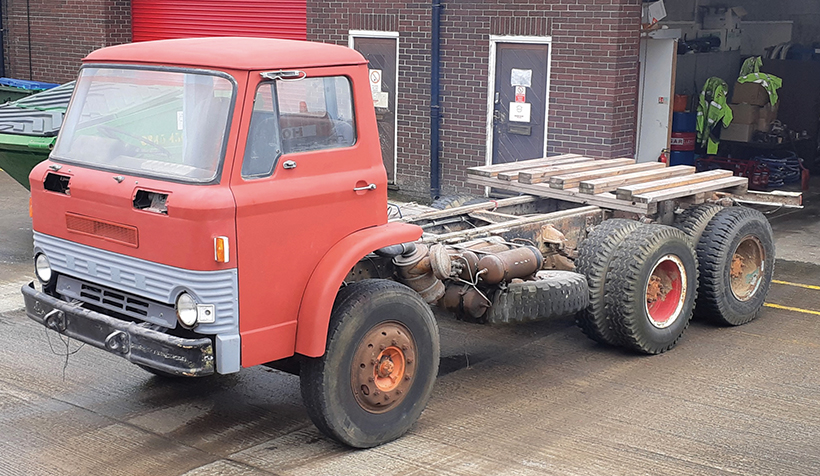
The rolling chassis cab unit. Now for the replacement, new-build body!
As the new wings were being fitted, it became obvious that the wing extension brackets (saved from the old cab) were completely rotten. “Ambrose Wood, from Bollinton, helped me out again, as they did when I restored my AEC Mammoth Major tanker, and fabricated new ones that fitted perfectly to the contours underneath. They also made some new wing stays for us from rusted pattens. They were difficult to make but were perfect when they’d been completed”.
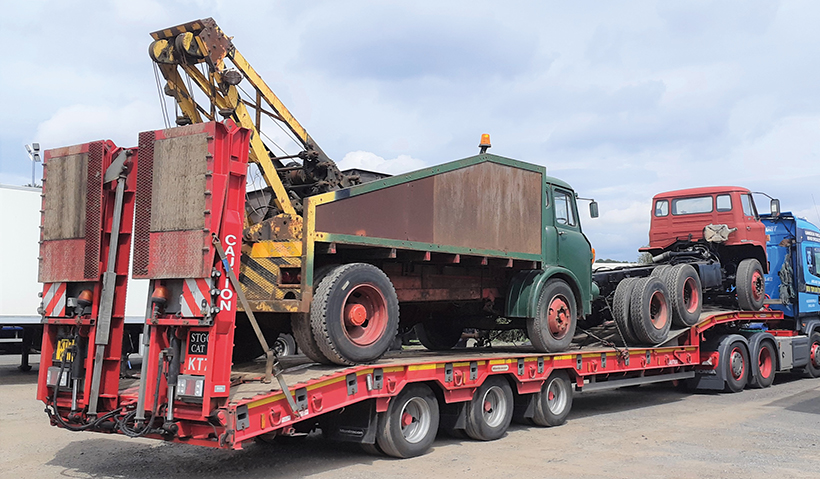
The Albion donor vehicle (paid for in part by the new body) and Ford D Series were transported to Paul Bibby’s yard.
Although some other work was needed to get the D Series back on the road, the brakes, steering and suspension were checked over and found to be in great order. “I think that it had benefitted from its easy ‘second life’, when it had been used occasionally as a lime-spreader at low speed across muddy fields,” Johnny said.
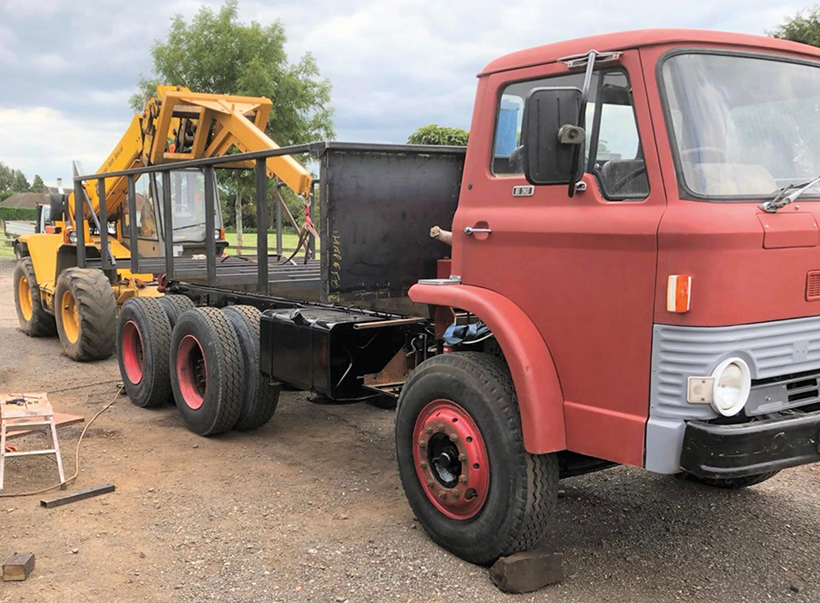
The frame of the new tipping body being checked for size on the chassis.
Its later life also reflected the state of the engine. “It was perfect,” Johnny said. “Paul agreed that the Perkins 540 V8 was quite healthy, and he was right.” The eight-speed gearbox was in good shape, too. “The D Series didn’t need a strip-down restoration as Geoff Wallman had really looked after it,” Incidentally, Johnny’s D-Series is one of two lime-spreaders that Geoff had, the other has been retained and is currently awaiting restoration.”
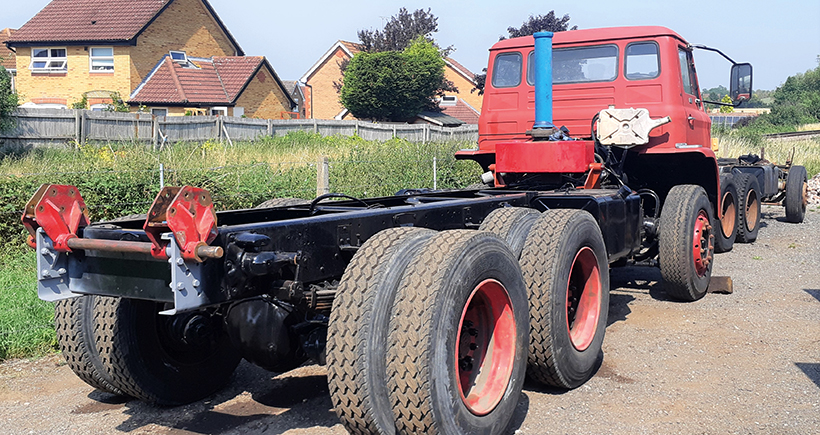
The tipping body mountings fitted to the chassis.
Throughout OPH’s restoration, Johnny was in regular contact with Paul Bibby, and asked him if he would be interested in building a body like the one that he had fitted to his D Series. “He had done such a good job on his D Series tipper, and I knew that he had some items that would be useful for my restoration,” Johnny said. These included a tipping ram and a set of hinges which were fitted to a Ford 4×2 D Series that was sitting in his yard, as well as another D Series that he used as a donor for his 6×4 tipper. “I wanted to buy these items and thought it would kill two birds with one stone if he transferred them to my truck and then built a body,” he added.
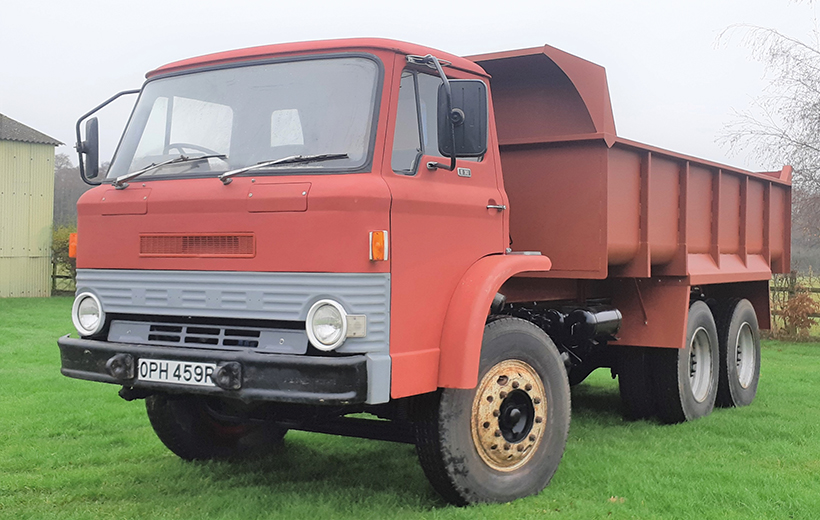
In dull red undercoat prior to the top, semi-gloss coat of paint being applied.
Unfortunately for Johnny, Paul was short of time as he was restoring his second Ford D series 6×4, this time an RMC mixer that he’d rescued from Rush Green Motors, as well as running his building business. Negotiations continued, Paul told Johnny that he’d think about the idea, but also mentioned that he was considering buying a rare LAD-cabbed Leyland Super Comet 20 that had also come from Rush Green Motors. “He told me that he would buy it if he could get a cab for it,” Johnny explained. “So, I said that I would try to get one for him.” Johnny knew where one could be obtained, and got in touch with Geoff Cox, to see if he would sell an Albion Chieftain ex-bus recovery vehicle that he owned at the time.
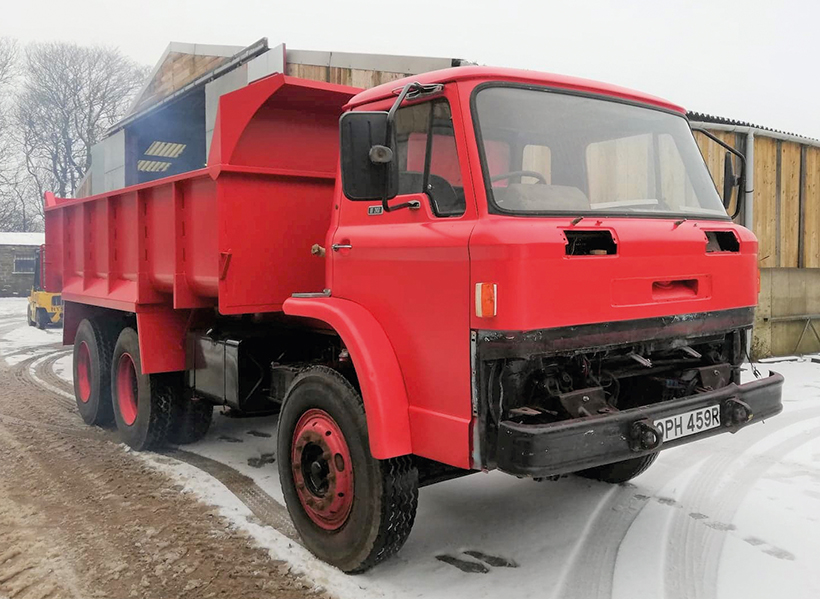
The final painting was carried out by D&S Coachworks, of Penistone.
A deal was agreed, and the Chieftain moved to Huddersfield. “I removed the pump and repaired the rack inside the injection pump to get it running,” Johnny added. “I then told Paul that I had an Albion with a good LAD cab that he could use as a donor.” Johnny didn’t feel guilty about breaking this lorry. “The chassis was in a very bad state, the recovery body was rotten and the hydraulic brakes were shot.” Paul was interested in the proposition after seeing the photos of the Albion donor vehicle, and duly went ahead and bought the Leyland. “We did a deal with Paul getting the Albion and building my tipper body in part payment.”

Nearly ready for the road.
There was still some work to do on the D Series chassis, though. “We removed items like the fuel tank and the old brackets from its mixer days. It was then blasted and painted for protection.” Some work was needed to convert the D Series from a lime-spreader to a tipper. Johnny had already bought a hydraulic pump from eBay. “I also used the same propshaft that powered the lime-spreader conveyor, once the PTO unit was piped-up, it worked perfectly.”
With the work on the chassis completed, it was time for the D Series and the donor Albion to make the trip south to Paul Bibby’s yard, in Worcester. There, the D Series’ body was built and fitted. It wasn’t, though, completely straightforward…

Johnny’s youngest son, Luke, who did a lot of work on the D Series, especially with the wings.
“It was a difficult fabrication,” Johnny explained. “Paul had to make new mountings to fit the ram, with plates having to be cut and bent to match the shape of the chassis, which gets wider around the gearbox bell-housing.” Some chassis work was also required. “Paul had to extend the rear of the chassis on one side. It had been cut down to accommodate some equipment on the lime-spreader’s body.” Again, the donor Ford was utilised, with a length of chassis being removed and fitted to the D Series. The rear crossmember also had to be moved forward so the rear hinge could be fitted.
Paul then started on the tipper body. “He built and welded the body from the ground up, with constant help from his ‘team’, Paul and Nick,” he said. The construction was similar to the one Paul employed with his own tipper. “The side plates were rolled at a nearby engineering firm and welded in, with the front cab protector being formed and a new tail board made. “The finished result was very impressive indeed,” Johnny said.

Paul’s tipping ram was available, but needed to be adapted. “Paul’s ram was manually controlled, but I had already fitted air controls in the cab. Alex Kelly, a mate from Ireland, sent one over and Paul fitted it.”
Paul also was responsible for some other work. “The exhaust system was missing, so Paul built a new one out of bits left over from his other restorations. Consequently, OPH now has a deeper V8 rumble than before.”
Once Paul’s work was completed, Kevin Taylor’s son, Benji, transported the D Series back up north, but the destination this time was Penistone, where D&S Coachworks did the painting, as had been the case with Johnny’s Reiver. A semi-gloss finish was applied, to give a cared-for, working lorry appearance.
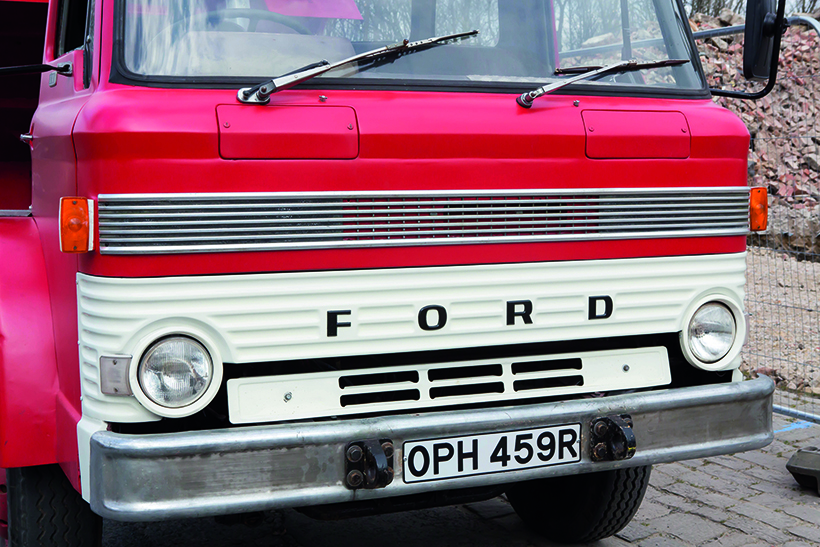
Back in Huddersfield, some jobs were completed, and further parts sourced, such as the aluminium beading strip the runs across the front of the cab, which was supplied by David Jones, plus a chrome bumper which came from Alan Dean. Johnny has also stripped the hubs and renewed bearings as well as air valves and a brake chamber. He’s also keen to acknowledge the help received during both restorations. “I’m very grateful to my son, Luke, and also to Alex Kelly who has encouraged me from the start to go for it! I’ve had continued support from Hoyer UK, but without Paul Bibby, this restoration would never have happened. What a great job he did.”
Both vehicles have been restored and conserved as working lorries, with dents here and there, and a twisted bumper; “a look that suggests that they have been hard at work. I’m sure ‘tipper men’ will understand, probably more than the general public, it’s just the way I like them!”
For a money-saving subscription to Classic & Vintage Commercials magazine, simply click here



